Ejercito del Aire / Spanish Air Force
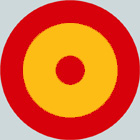 Credit: Roundels of the world
Credit: Roundels of the world
Roundel
Last update 19-11-2020
The
United States had beginning 1960's offered as new supersonic fighter either the Northrop F-5A, the North
American F-100 or the Convair F-102 but Spain insisted and obtained the
very expensive Starfighter.
Initial replacement for some of the North American F-86F were 21 Lockheed F-104G/TF-104G (prestigeous aircraft but complicated to fly and to maintain) first seven delivered by the USA in May 1965 supplied
under the US Military Assistance Plan. The country was unable to
obtain enough aircrafts to replace all the Sabre and contemporanely modernise its
aircraft industry. It realised that a simpler aircraft, less expensive
fighter was needed to be bought and also built in Spain.
Discussions for
the acquisition
of 100 Northrop F-5 Freedom Fighter to replace the old North American
F-86F, equipping several fighter units, started in May 1960, in June
1962 Northrop acquired a package of
shares as a first step, followed by
a second one in February 1964 to bring the Northrop share holding to 24
percent, financial interest withdrawn in 1989.
Signature of the manufacturing contract between CASA and Northrop took place on 12-11-65; definitive purchase was only announced by CASA and the Council Ministries on 17-12-65, by the Spanish
Defence
Ministry on 06-01-66. It concerned 70 aircrafts of the
fighter/trainer versions at the cost of 2'800
millions
Pesetas. These were to be built locally by Construcciones
Aereonauticas S.A. (CASA) at their
Madrid-
Getafe plant, which had obtained the authorisation to build
them under licence giving an enormous transfer of technology to the local aviation community.
The contract was valued at USD 64.5m of which USD 42.6
represented the direct manufacturing costs, unit price being
approximately USD 750'000. Production
started with the double-seaters in order to train pilots
to the new
supersonic fighter was
signed on 20-12-65, ratified by the Spanish parliament on 20-02-66
specifying that the first 10 aircrafts were to be delivered on
20-06-69.
Delivery dates were specified as
follows: 10 aircrafts within 40 months of contract signature, another
10 within 48 months, followed by 10 within 54 months, 10 within 58
months, 10 within 62 months, 10 within 66
months and 10 within 70
months.
The programme had four phases:
1) the first two aircrafts were built from major assemblies
supplied by Northrop; 2) the next three were knocked-down assemblies
, CASA undertaking all systems installation;
3) parts were supplied by Northrop for additional three; 4) airframes from the ninth one were completely CASA built.
Initial order was for 36 single- and 34 trainers
but this was modified to 18 fighter, 18 reconnaissance aircrafts and 34 trainers in 1971; these were locally
designated CASA/Northrop SF-5A, SRF-5A, SF-5B, their
military designation being respectively C.9, CR.9, CE.9. First to be built were the two-seaters, followed by the single- and last by the reconnaissance versions.
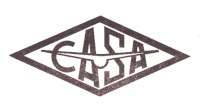
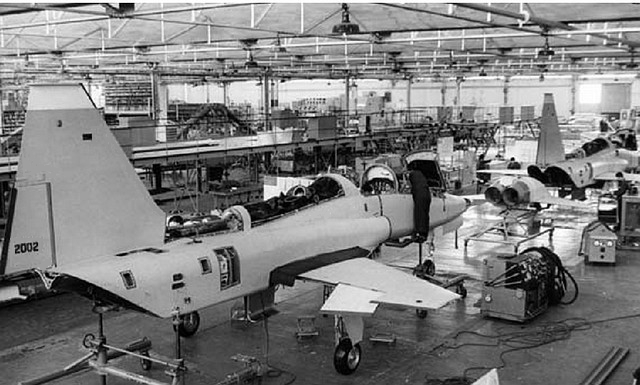 Photo: CASA
Photo: CASA
The second
two-seater on the CASA Getafe production line.
Roll-out of the first aircraft (SF-5B serial
CE.9-001) at Getafe was on 11-05-68, followed by its first flight on
22-05-68; four others flew by the end of the year. The first one was officially
handed-over (together with
nine others) after trials to the Ejercito del Aire on
19-06-69, again at Getafe AB.
Six pilots instructors and 12 technicians were sent to Williams AFB (USA) following conversion to the fighter; delivery completed in September 1970 allowing formation of a
second Squadron (204). These units formed part of the Aviacion Tactica (Tactical Airforce)
The first reconnaissance aircraft flew in 1970 and production was completed with delivery to the Air Force of the last CASA/Northrop SRF-A oin 11-04 1972.
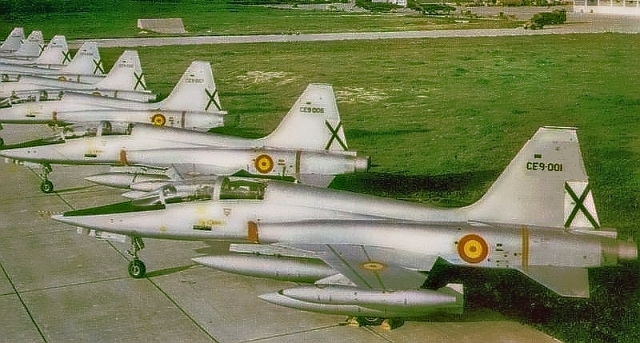 Photo: CASA
Photo: CASA 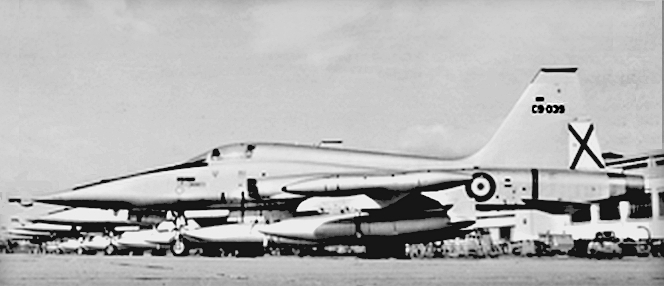
First
eight CASA/Northrop SF-5B awaiting delivery to the Spanish AF at Getafe airport on 16-06-69.
CASA/Northrop SF-5A C9-039 in a full tanks configuration shortly before delivery to the Air Force.
Photo: Airbus Military
Enmasa company was
entrusted with the main overhaul and repairs of the General Electric J-85
engines, this work being transferred to CASA Division de Motores by 1978.
The Air Force took care from the very beginning of the periodical
engine overhauls between 200 and 1'200 hours at Talavera la Real
AB.
Six instructors were sent to the USA in 1968 receiving training on the Northrop T-38A and some hours on the Northrop F-5. They were based at Moron on return to Spain and entrusted with the transfer of the new
aircrafts to this base and with the training of local pilots.
Both
double- and single-seaters aircrafts were distributed to the 202
Squadron and 204 Squadron, these being dissolved in
September 1971 the Northrop F-5Bs being transferred mainly to the Jet
School and the
single-seaters, with some two-seaters, to operational
Squadrons, see the Spanish AF Units page for details.
Selection of a
new fighter to replace Freedom Fighters in the fighter role was started in February 1978, candidates were
the more advanced version Northrop F-5E, the McDonnel-Douglas F-15, the Grumman F-14A,
the General Dynamics F-16A, the GAMD Mirage 2000, the Northrop YF-17, the McDonnel-Douglas F-18A, this last one being
selected in 1979.
Three Spanish test pilots had perfomed, after having been
trained in Spain on the CASA/Northrop SF-5B and SF-5A, 07.40 flight
hours between the 13th and 15th June 1978, in seven flights on the Northrop F-5E
at the Edwards AFB
(USA) base between June 13th and 15th, 1978.
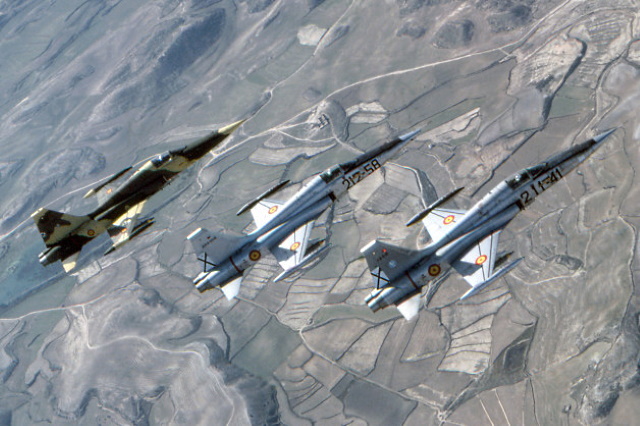 Photo: Spanish Air Force
Photo: Spanish Air Force
In-flight view of Northrop/CASA SF-5A 211-41, RF-5A 212-58 and an
unknown camouflaged SF-5A
A change to military serials took place in April 1978, the SF-5A being reserialled as A.9 (attack), the SRF-5A as AR.9 (attack/reconnaissance), the SF-5B as AE.9 (attack/training). Repainting of the Freedom Fighters
in camouflaged colours started also 1979.
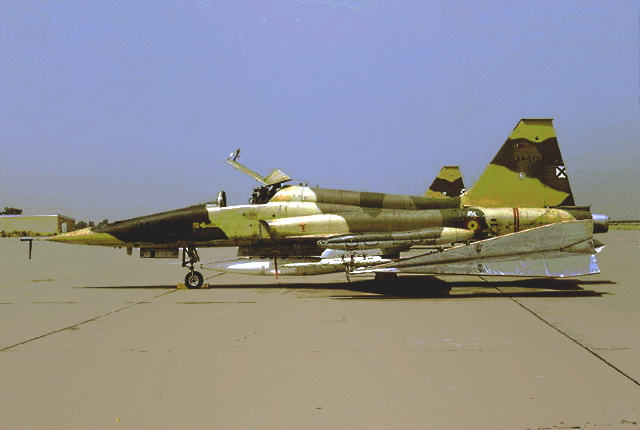 Photo: collection Northrop F-5 Enthusiast
Photo: collection Northrop F-5 Enthusiast
Camouflaged CASA/Northrop SF-5As were used exclusively for
ancillary operations, herewith with Dart target.
CASA/Northrop F-5 losses between 1977 and 1986 were high: 10 aircrafts -
1 in 1977, 1 in 1980, 2 in 1981, 2 in 1982, 1 in 1983, 1 in 1984, 1 in
1985, 1 in 1986, surely necessitating an update to the airframes.
The missile AIMP-9 was integrated on the CASA/Northrop SF-5B and was
launched for the first time in 1983 at the Arenosillo (Huelva) poligon.
First upgrade to CASA/Northrop SF-5B+
A life extension study (called Programa SLEP) was initiated following the in-flight detachment of the aileron of CASA/Northrop SF-5A AE.9-033 on
28-04-89 for the life extension (about 3'000 hours) of the remaining
airframes and a first
programme to upgrade the structure of 23 CASA/Northrop F-5B, to
be performed in collaboration with the Canadian company Bristol
Aerospace, particularly regarding the wings, the lower fuselage,
the
vertical stabilizator, the landing gear and the dorsal longerons. The definitive contract was signed with CASA in December 1990.
All these
modifications were not foreseen for the single-seaters; they were to used for target-tug and operational training and be
withdrawn when reaching their flying hours limits, the last in 1992. Remaining
reconnaissance aircrafts were anyhow subject to a
limited sensor
upgrades to improve their capabilites starting from 1999, the last operational one crashed on 30-04-03.
Plans
were established to return the first modified two-seater to the Air
Force on 24-06-91 and the last one on 12-12-94, but the first one was
handed over to CASA only on 20-03-91, resulting in an overall delay:
the last aircraft of those initially foreseen was returned to the Air
Force on 05-12-95, an additional one (modified from an accidented
airframe - AE.9-029 - seen hereunder on take-off), followed on 04-08-96.
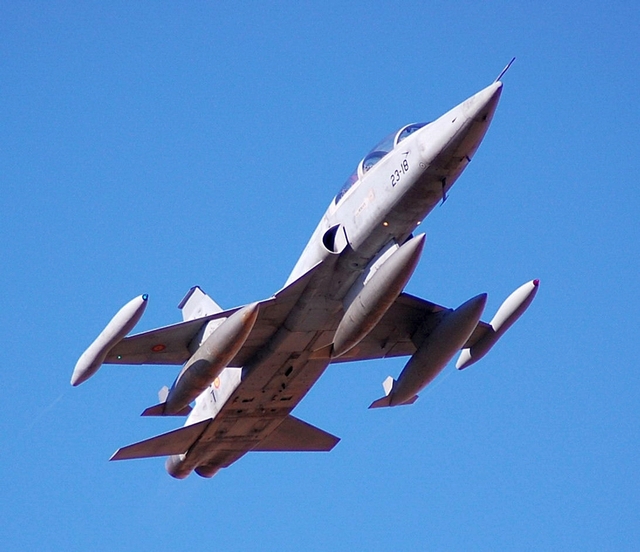 Photo: unknown
Photo: unknown
Starting from 1992 the remaining 21 Ala at Moron
single-seaters (CASA/Northrop F-5A, RF-5A) and 4 CASA/NORTHROP SF-5B
started to be transferred in-flight or by road (if unable to fly) to
Talavera AB. Seven
single-seaters were kept flyable.
Second upgrade to CASA/Northrop SF-5M and SF-5M+
A major overhaul
programm of the avionics and airframe was needed following the decision to keep 22 CASA/Northrop F-5B in operation till the 2020s.
Boeing,
IAI, Elbit and SAGEM responded to the request for offer issued by
Spain; the tender was won by IAI/Lahav division as main contractor and EADS/CASA/INDRA as sub-contractor.
An upgrade plan in two phases,
due to budgetary limitations, was established. The first phase concerned the avionics: it included a board computer, a
virtual radar, an HUD, new navigation (VOR/ILS and INS/TACAN)
and
communication (VHF/UHF) systems, software very similar to the McDonnell
EF-18. An initial modest fuselage upgrade was also foreseen: modification of the bulkhead and the wingtips to accept AIM-9J Sidewinder
instead of the AIM-9B.
All these changed justified the redesignation to CASA/Northrop
SF-5M of the aircraft.
A first contract (value 21m Euros) was signed on 17-06-00 only for four prototypes Following
full satisfaction, another contract
for the remaining 18 followed on 17-12-02 for a total value of more than 31 millions Euros.
Four aircrafts were sent to EADS/CASA
plant at Getafe to be upgraded as prototypes; first flight of a modified
aircraft (AE.9-09)
was on 12-09-01 at the same base, first of four prototypes was handed
over during
the summer 2002 to the Centro Logistico de Aemamento y
Experimentador (CLAEX, experimental unit) at Torrejon AB which took care of the development and test of the new software and sent back to the Ala 23
on 10-07-02 after more than 50 check flights.
The first modernized production Northrop F-5M left the company EADS-CASA at Getafe airport on December 2003. These prototypes were used for the first training course which started on 01-09-03, being
completed on 14-06-04.
Finally 17 additional CASA/Northrop
SF-5B were to receive the first phase upgrade, work was begun in 2003,
first leaving Talavera La Real AB on 15-10-04; the last CASA/Northrop SF-5B+ modified to SF-5M was
handed over to the Ala
23 on 10-05-07;
this was contemporaneously the last one which received
the avionics upgrade and the second prototype of the structural
upgrade. The goal was to keep the trainers operational
till the year
2020.
The
second phase, structural upgrade of the aiframe started with the
signature in November 2003 of the modification
contract. First delivery of an SF-5M (AE.9-014) for
modification to Albacete
AB was on
16-09-05; first flight of the prototype followed on 04-12-06, two prototyes
being completed by the end of the year, while the first production modified aircraft was completed by 09-07-07. Three hed been returned
to the Ala 23 by November 2007.
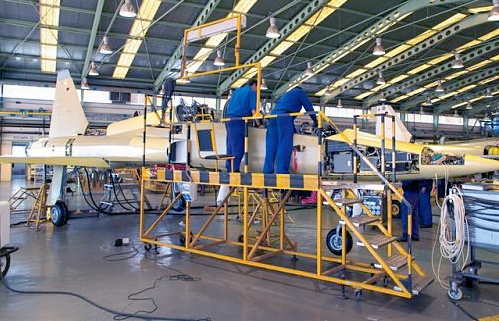 Photo: unknown
Photo: unknown
CASA/Northrop SF-5Ms undergoing modifications.
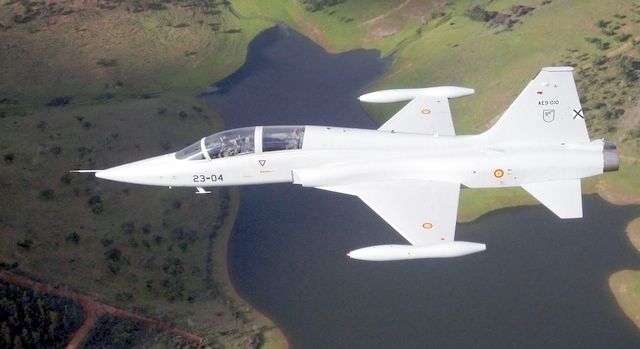 Photo: aircraftinformation.info
Photo: aircraftinformation.info
Contrast rich picture of
all-grey EADS/Northrop SF-5M+ 23-04 AE9.010
A contract was signed with Martin Baker during this year for the replacement of the old Northrop
ejection seat with the Martin Baker Mk.16L, enabling ejection between 0
and 550 knots and 0 feet. First flight of an
modified aircraft took
place on 17-09-08.
An important step was the offer in January 2007
to house at Talavera la Real AB
the Advanced European Jet Pilot Training, in
competition with Sweden (Lulea AB, Östersund AB or
Söderhamn AB), Greece
(Kalamata AB or Araxos AB), Finland (Kauhava
AB), Portugal (Beja AB), France/Belgium (Cazaux AB), Italy (Lecce AB)
as well as the USA/Canada with their Joint Jet Pilot Training and
NFTC, but interest in establishing
this school has sensibly diminished over the years and no decision has been taken byl January 2017. Lecce AB provides (2019) advanced training to pilots of several countries on Leonardo M-346.
Spanish company INDRA obtained in October 2010 a contract for new flight simulators
of both EADS-CASA/Northrop SF-5M and McDonnell F/A-18 for the value
of 4.33m Euro, based at Talavera la Real AB. This was
coded 23-00.
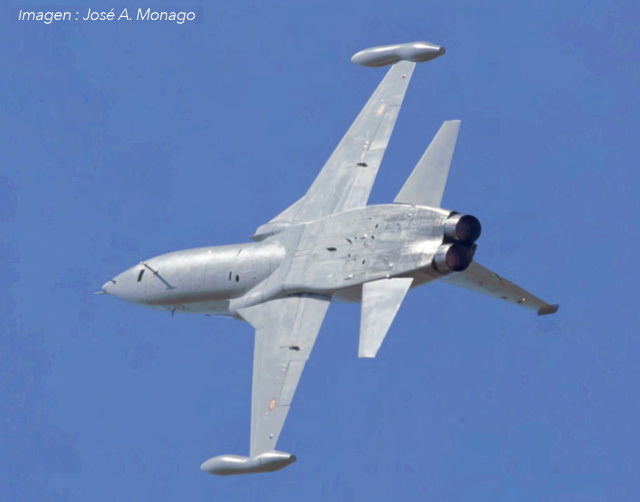
Clean Underfuselage view of a CASA/Northorp F-5M
Five aircrafts entered each year the structural upgrade/modernisation process, which lasted between 2 and 3 years.
A total of twelve
structural upgraded aircrafts have been seen by June 2012; re-delivery of the last
one was in 2016, allowing the
prolonguement of the fleet's operational life till 2024. Depot level maintenance and engines are completed at Talavera la Real AB, structural maintenance is taken care at Albacete AB.
A further step was the installation of new wings to the trainers starting from February 2011.
Cassidian (formerly EADS Defense) signed in November 2011 a contract for structural upgrade of 5 additional CASA/Northrop SF-5M at Getafe AB. No sightings have ben reported of these additional aircrafts, and
possibly have not been modified or they were included in the earlier contract.
A
new, national training aircraft has been searched in order to replace
the fleet of ENAER T-35C and CASA
C-101 Aviojet to be designed and developed locally and to be
operational late 2021/early2022. According
to the
latest informartion it was not possible to develop the aircraft
in Spain due to financial and technical problems; 24 Pilatus PC-21
trainers were ordered beginning 2020. It is not known how this will
effect
the use of CASA/
Northrop SF-5M+ now used in the advanced training role.
The CASA/Northrop aircraft is now scheduled to be retired aroung 2028.
The Spanish Air Forces celebrated on 12-11-20 the 50th anniversary of
use of the Freedom Fighters on the Talavera la Real air base; the tail
of the CASA/Northrop F-5M was painted in special colours to commemorate
the event. Retirement of the 19 CASA/Northrop F-5M used for the third
and fourth fighter pilots training is foreseen during the year 2028. Obsolescence of avionics and
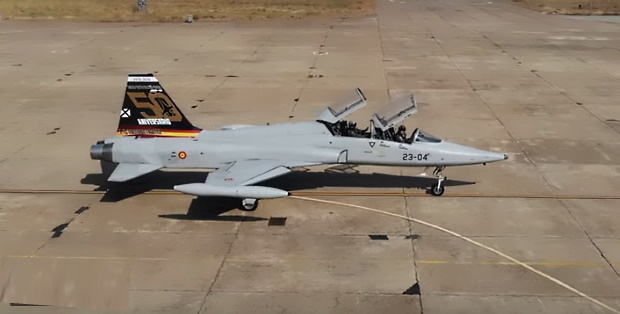
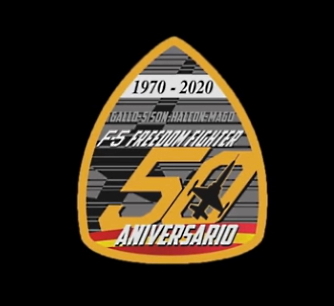
CASA/Northrop SF-5B+ code 23-04, serial A.9-10 with commemorating tail
colours
50 years in-service commemoration badge
Subsitution of the 19 CASA/Northrop
SF-5B+ is not foreseen before 2030. In the meantine the Mando de Apoyo
Logistico has awarded directly to Silicin Aviacion (Spanish representative of Israel IAI
company) a contract
divided into four periods to
modify the aircrafts: in 2023 and 2024 each for USD 15 milions, in 2025
and 2026 each for USD 5 millions. The modifications include:
analysis, drawings, building a prototype, air trials (of the
various subsytems composing avionics system) plus replacement of the lower and upper spars of the front fuselage.

 Credit: Roundels of the world
Credit: Roundels of the world
 Photo: CASA
Photo: CASA Photo: CASA
Photo: CASA 
 Photo: Spanish Air Force
Photo: Spanish Air Force Photo: collection Northrop F-5 Enthusiast
Photo: collection Northrop F-5 Enthusiast Photo: unknown
Photo: unknown Photo: unknown
Photo: unknown Photo: aircraftinformation.info
Photo: aircraftinformation.info

